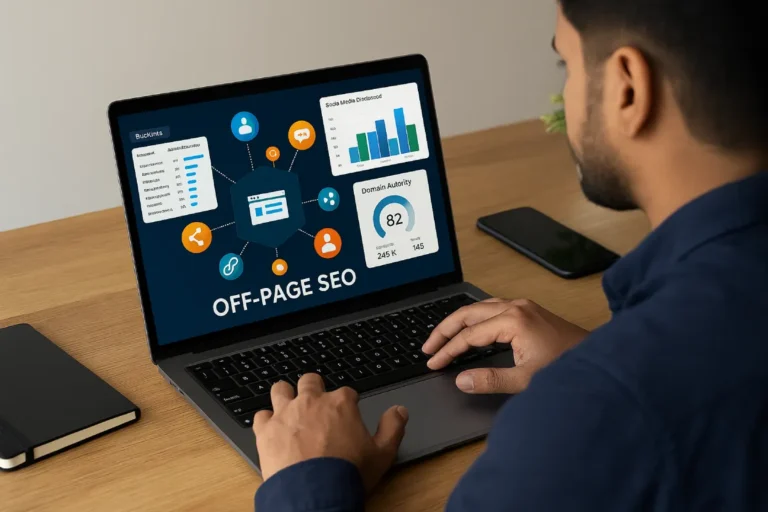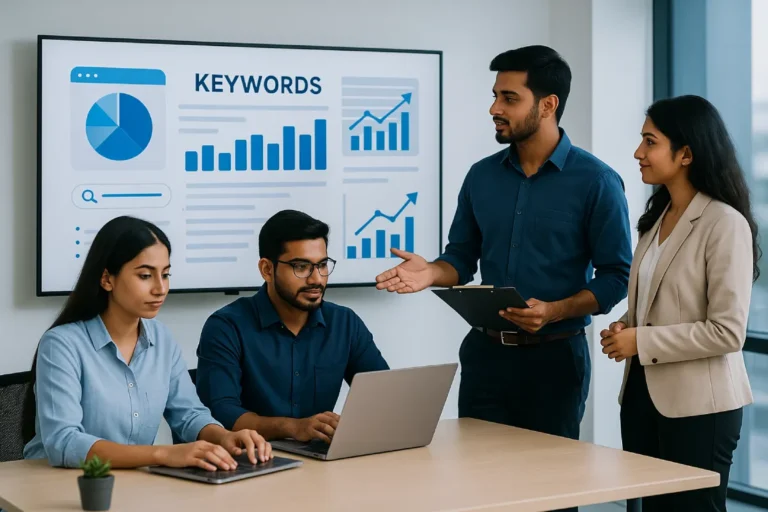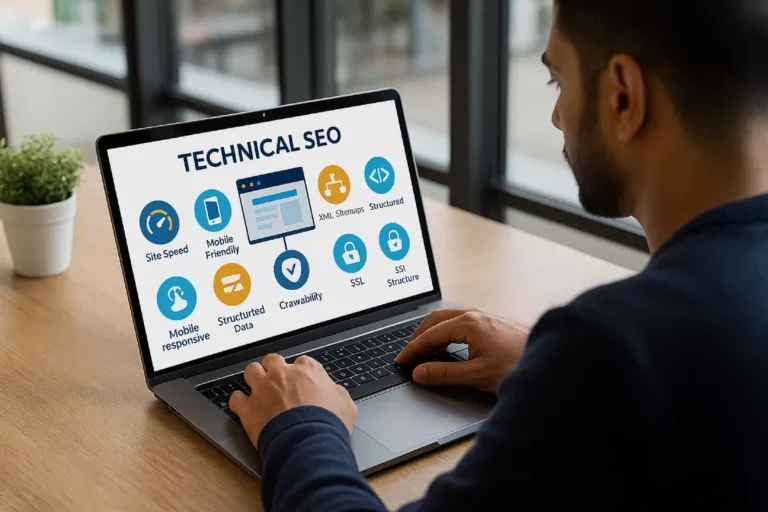Types of SEO: A Comprehensive Guide to Different Strategies
Think of SEO like a well-balanced meal. On-page SEO is your main course — the substance that keeps visitors engaged. Off-page SEO is your seasoning — the external factors that enhance flavor. And technical SEO? That’s your cooking method — the process that ensures everything works smoothly behind the scenes.
In this guide, we’ll break down the main types of SEO and explain how each one contributes to better rankings and online growth. By the end, you’ll have a clear roadmap for implementing them on your own website.
1. On-Page SEO: The Foundation of Your Website’s Visibility
On-page SEO (also known as on-site SEO) involves optimizing the elements within your website that you can directly control. These optimizations help search engines understand what your page is about and ensure users have a great experience when they visit.
Key Elements of On-Page SEO
- Keyword Optimization – Use relevant keywords naturally in your titles, meta descriptions, headings, and throughout your content. Avoid keyword stuffing and focus on matching the user’s intent.
- Example: If you’re a bakery in Mumbai, instead of repeating “best bakery in Mumbai” too often, use variations like “top cake shop in Mumbai” or “Mumbai bakery for custom cakes.”
- Example: If you’re a bakery in Mumbai, instead of repeating “best bakery in Mumbai” too often, use variations like “top cake shop in Mumbai” or “Mumbai bakery for custom cakes.”
- High-Quality Content – Create helpful, original, and engaging content that solves user problems. Google prioritizes expertise and value over keyword density.
- Action Step: Before writing, list 3–5 questions your audience might ask and answer them thoroughly.
- Action Step: Before writing, list 3–5 questions your audience might ask and answer them thoroughly.
- Meta Tags and Descriptions – Your meta title and description appear in search results and directly impact click-through rates. Keep them clear, keyword-rich, and under 160 characters.
- Internal Linking – Link to other relevant pages on your site to help users (and search engines) navigate smoothly.
- Action Step: Add 2–3 internal links to related blog posts or service pages.
- Action Step: Add 2–3 internal links to related blog posts or service pages.
- Image Optimization – Use descriptive file names and alt text to help Google understand your visuals. This also improves accessibility and image search visibility.
- User Experience (UX) – Ensure your site is easy to navigate, mobile-friendly, and loads quickly. A slow or confusing website can drive users (and rankings) away.
2. Off-Page SEO: Building Authority and Trust
Off-page SEO refers to the actions you take outside your website to strengthen its reputation and credibility. Google sees external links and mentions as signals that your content is trustworthy and worth ranking.

Key Elements of Off-Page SEO
- Backlink Building – Acquire high-quality backlinks from reputable websites. Backlinks act as “votes of confidence” that tell search engines your content is valuable.
- Example: Guest posting on an industry-relevant blog or being featured in a local news article with a link to your website.
- Example: Guest posting on an industry-relevant blog or being featured in a local news article with a link to your website.
- Social Media Engagement – While social signals (likes and shares) aren’t direct ranking factors, they help spread your content to wider audiences and attract organic backlinks.
- Action Step: Share every new blog post on LinkedIn, Instagram, and Facebook to increase reach.
- Action Step: Share every new blog post on LinkedIn, Instagram, and Facebook to increase reach.
- Online Reputation Management – Respond to reviews, manage brand mentions, and maintain a positive presence on sites like Google Business Profile and Yelp.
- Influencer Collaborations – Partner with influencers in your niche to create content that drives both traffic and authority.
- Local Citations – For businesses with physical locations, list your company on local directories (Google Maps, Justdial, Sulekha, etc.) with consistent name, address, and contact information.
3. Technical SEO: The Backbone of Your Website’s Performance
You could have the best content in your niche, but if your website isn’t technically sound, Google may never rank it. Technical SEO ensures your site runs smoothly and is easy for search engines to crawl and index.

Key Elements of Technical SEO
- Website Speed Optimization – Compress images, enable caching, and use a fast hosting provider to ensure your pages load within 2–3 seconds.
- Action Step: Use tools like Google PageSpeed Insights or GTmetrix to test and improve your speed.
- Action Step: Use tools like Google PageSpeed Insights or GTmetrix to test and improve your speed.
- Mobile-Friendliness – With most searches coming from mobile devices, a responsive design is essential. Check how your site looks and functions across different screens.
- Secure Website (HTTPS) – Having an SSL certificate not only protects your site but also builds user trust. Google prefers secure websites.
- XML Sitemaps and Robots.txt – These help search engines understand your website structure and determine which pages to crawl or ignore.
- Fixing Errors – Regularly audit your site for broken links, duplicate pages, or crawl errors that can hurt rankings.
- Structured Data (Schema Markup) – Add schema markup to help Google display rich results, such as star ratings, FAQs, and product details.
- Example: Adding the FAQ schema to your service pages can make your search results more attractive and clickable.
- Example: Adding the FAQ schema to your service pages can make your search results more attractive and clickable.
4. Local SEO: Dominating Searches in Your Area
Local SEO focuses on increasing visibility for businesses that serve specific geographic areas. It’s crucial for brick-and-mortar stores, restaurants, and service providers who want to attract nearby customers.

Key Elements of Local SEO
- Google Business Profile Optimization – Claim and verify your business listing. Add accurate information, photos, and respond to customer reviews.
- Local Keywords – Use location-based terms like “plumber in Bangalore” or “best salon near me” throughout your website content.
- NAP Consistency – Ensure your Name, Address, and Phone number are consistent across all online listings.
- Local Backlinks – Get links from local blogs, newspapers, or community websites.
- Customer Reviews – Encourage happy clients to leave positive reviews on Google and other platforms.
5. Content SEO: Creating Value That Ranks
While on-page SEO focuses on structure, content SEO ensures that your text, videos, and visuals are designed to attract and engage readers while satisfying search intent.
Best Practices for Content SEO
- Understand Search Intent – Before creating any content, identify whether your audience is seeking information, comparison, or a purchase.
- Write for Humans First – Keep your tone conversational and easy to understand while naturally including keywords.
- Use Clear Formatting – Break your content into short paragraphs, bullet points, and subheadings.
- Include Visuals – Add images, infographics, and charts to make content more engaging.
- Update Old Content – Refresh outdated posts with new information or statistics to maintain rankings.
6. E-commerce SEO: Optimizing for Online Stores
For businesses that sell products online, e-commerce SEO focuses on improving product visibility and conversion rates.

Key Tactics for E-commerce SEO
- Optimize Product Titles and Descriptions – Use descriptive and keyword-rich phrases that clearly explain the product.
- High-Quality Product Images – Use optimized images with alt text describing the product.
- Product Reviews – Display verified customer reviews to build trust and improve rankings.
- Site Architecture – Keep your category and product pages easy to navigate.
- Avoid Duplicate Content – Each product should have a unique description to avoid confusion.
Conclusion: Combine All Types of SEO for Maximum Impact
SEO is not a single tactic — it’s an ecosystem. On-page, off-page, technical, local, content, and e-commerce SEO all work together to boost your site’s visibility, authority, and user experience.
Remember, SEO is a long-term investment. The more you learn and apply, the stronger your online presence becomes. Keep experimenting, stay updated with Google’s algorithm changes, and watch your website climb the search results!
If you’re a business looking to improve your online visibility, working with a professional SEO company in Bangalore can help you get measurable results. At Digirank, we specialize in providing data-driven SEO strategies that help brands rank higher, attract qualified leads, and grow sustainably.







